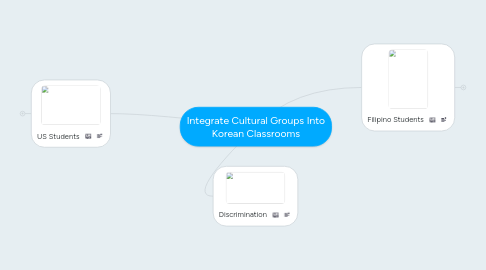
1. Filipino Students
1.1. Introduce the language using flashcards with Korean letters phonics related to English phonics sounds
1.1.1. Who: Teacher
1.1.2. What: Introduction to language relative to mother tongue
1.1.3. When: First day/week small group sessions or 1 on 1
1.1.4. Where: In classroom in small groups or 1 on 1 during practice time
1.1.5. Why: To introduce usable decoding
1.1.6. How: Using flashcards with both Korean and English phonics sounds/words
1.2. Put the ELL students in a small group for a few minutes in class during free practice/study time to give them extra instruction.
1.2.1. Who: ELL Students and teacher
1.2.2. What: Small group instruction/practice
1.2.3. When: During practice time/study time
1.2.4. Where: In class in an area a little bit away from other students
1.2.5. Why: To give individual attention and help
1.2.6. How: Use flash cards and allow extra time for students to grasp/learn information
1.3. Put child in group and have the group be responsible for saying the proper answer. This helps students teach the proper answer to each other.
1.3.1. Who: ELL student and other students
1.3.2. What: Collaborative effort to learn material
1.3.3. When: During quiz/review time
1.3.4. Where: In the classroom
1.3.5. Why: To help students include the ELL student and for overall group learning
1.3.6. How: Give points for right answers and the whole group working together. This motivates the good students to help the struggling students (not just ELL) learn the right answer
1.4. Have an activity where children list the good traits of each person. Also have an activity where children think of the ways they are alike. Teachers begin the activity
1.4.1. Who: Students (including ELL students) and teacher
1.4.2. What: Go around saying one positive thing about the next student
1.4.3. Where: Anywhere but most likely in the classroom
1.4.4. When: After the ELL student has learned some basic language skills / after child has been discriminated against
1.4.5. Why: To help children accept that all people have good traits and to help students not discriminate those who are different
1.4.6. How: The teacher begins by naming a student and one good thing/trait about that student. Then the student says one good thing about the student sitting behind/next to him/her
1.5. Have the ELL child make a poster/presentation about their home culture/country. Get help from the parents or help the child
1.5.1. Who: ELL child, parent, and teacher
1.5.2. What: Make a poster about ELL child's home culture and country
1.5.3. When: After ELL child has some grasp of the local language/child is discriminated against
1.5.4. Where: In the classroom
1.5.5. Why: To help other students have interest in the diverse culture of the ELL student/ To help students be less discriminatory and more accepting of the ELL student
1.5.6. How: Have the student make a poster with a few pictures about home and ask the parents if they can make any cultural food. The teacher will help the student make the poster and give ideas.
2. US Students
2.1. Introduce the language using flashcards with Korean letters phonics related to English phonics sounds
2.1.1. Who: Teacher
2.1.2. What: Introduction to language relative to mother tongue
2.1.3. When: First day/week small group sessions or 1 on 1
2.1.4. Where: In classroom in small groups or 1 on 1 during practice time
2.1.5. Why: To introduce usable decoding
2.1.6. How: Using flashcards with both Korean and English phonics sounds/words
2.2. Put the ELL students in a small group for a few minutes in class during free practice/study time to give them extra instruction.
2.2.1. Who: ELL Students and teacher
2.2.2. What: Small group instruction/practice
2.2.3. When: During practice time/study time
2.2.4. Where: In class in an area a little bit away from other students
2.2.5. Why: To give individual attention and help
2.2.6. How: Use flash cards and allow extra time for students to grasp/learn information
2.3. Put child in group and have the group be responsible for saying the proper answer. This helps students teach the proper answer to each other.
2.3.1. Who: ELL student and other students
2.3.2. What: Collaborative effort to learn material
2.3.3. When: During quiz/review time
2.3.4. Where: In the classroom
2.3.5. Why: To help students include the ELL student and for overall group learning
2.3.6. How: Give points for right answers and the whole group working together. This motivates the good students to help the struggling students (not just ELL) learn the right answer
2.4. Have some reading books in the English in the classroom so the child knows that English is not wrong, just different.
2.4.1. Who: Teacher and students in class (including ELL student)
2.4.2. What: Provide books in the native language of the ELL student
2.4.3. When: When the ELL student gets discouraged and feels punished for speaking his/her home tongue
2.4.4. Where: In the classroom
2.4.5. Why: To help the ELL student know that their home tongue is not wrong, just different/ to help other students have some appreciation of other cultures
2.4.6. How: Stock some books in the native language of the ELL student. The student can explain it to other students in class
2.5. Teach the children the basics of Korea’s social hierarchy and the importance of using honorific titles for older people.
2.5.1. Who: ELL students and teacher
2.5.2. What: Teach the importance of honorifics and polite speech to your elders
2.5.3. Where: In a small group in the classroom
2.5.4. When: During practice time or during weekly small group meetings
2.5.5. Why: Teaching how to respect elders it is the part of Korean culture that is very different from US culture. Respecting elders just because they are older.

